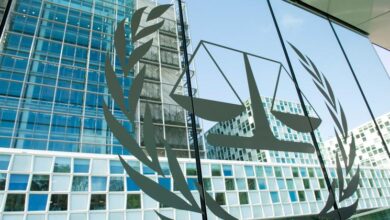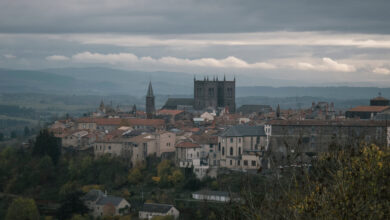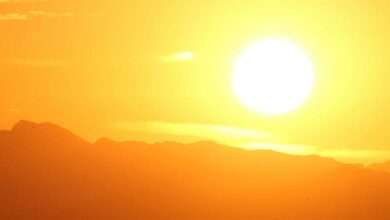Trump’s threats cast an ominous shadow over Greenland’s icy fjords
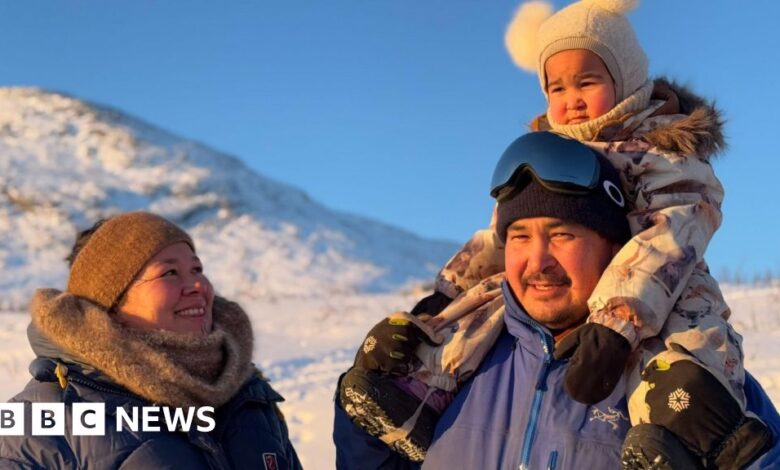
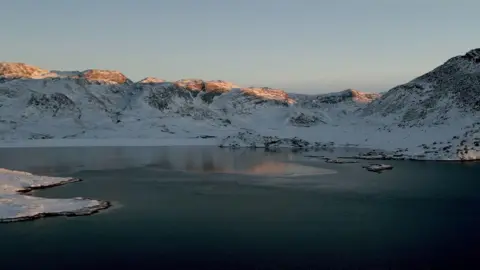 BBC
BBCThe sun is rising over the ice-capped mountains of Nuuk Fjord and we’re traveling along one of the world’s last wild frontiers.
But there are shadows gathering here and across the rest of Greenland’s frozen expanse.
With Donald Trump about to become president of the United States, Mr refused to rule out taking Greenland by force is reverberating through conversations across the island.
“He would certainly be pleased to visit,” said the captain of the converted fishing boat taking us east. Conscious that he needs to do business with people of all political stripes, he asked not to be named but used a phrase I’ve heard many times here.
“Greenland belongs to the people of Greenland. So Trump can visit but that’s it.”
The water was calm as we entered the isolated settlement of Kapisillit – population about 40 – where several hunters were preparing to shoot seals.
The temperature was -16C (3F) and with the wind chill effect it felt more like -27C.
But near the harbor, I met a local church elder, 73-year-old Kaaleeraq Ringsted, a great-grandfather, who was drying fillets of cod caught in the fish-rich waters next to his front door.
When I asked about President-elect Trump buying or invading Greenland, he initially chuckled. Then his tone became serious.
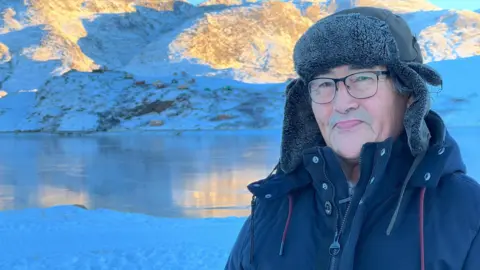
“For him to say this is unacceptable. Greenland is not for sale.”
Then he told me how he learned to fish and hunt here with his father and grandfather and how he wanted to preserve this life for his children and grandchildren.
Crossing the bay, the boat plowed through broken ice on the surface. Two eagles perched on a rock, searching for fish in the clear water.
We were heading to the farm of Angutimmarik Hansen, who raised sheep as well as hunted seals, wild birds and rabbits.
All winter food for his sheep is imported from Denmark, a reminder of how the harsh climate determines the viability of life here.
Inside his front door is a rack of shotguns. He noticed me looking at them.
“That’s in case there’s an invasion,” he joked.
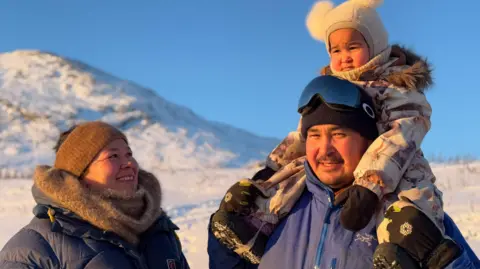
But his attitude toward the aggressive rhetoric from Mar-A-Lago is anything but comfortable.
“What a stupid person in the world like Trump,” he said. “We will never sell Greenland.”
The small farm is about 3,000 miles (4,828km) from Florida, where the incoming US president held his infamous press conference last week.
“But Trump is not the United States,” Mr. Hansen said. We can work with the American people.”
The Trump effect has gone into overdrive Donald Trump Jr.’s appearance in Greenlandhot right after his father’s statements. He flew to the capital Nuuk on the family’s 737 jet – Trump Force One – and stayed for four hours and thirty-three minutes, meeting a few locals and making only polite remarks.
“It was great to meet everyone and everyone was happy to see us,” he said after lunch at a local hotel. “Dad will have to come here.”
Then it’s back to the sunnier climate of Florida.
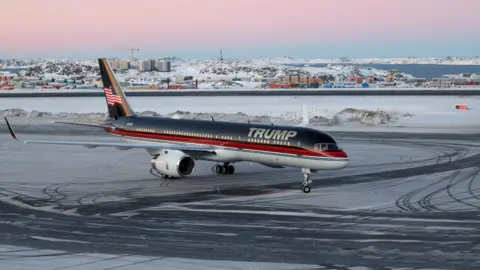 Reuters
ReutersTrump Jr. was greeted by local businessman Jorgen Boassen, who campaigned for the president-elect.
He told local media that he was Trump’s “biggest fan” and that “of course they care about our country, and they are welcome to come see what our country is like. That’s also is about opening up trade and cooperation.”
The city of Nuuk is the world’s most northerly capital. It has a thriving civil society and a strong press. And there is some satisfaction here in that Trump’s comments have pushed the debate about Greenland’s independence onto the international stage.
Campaigners such as Kuno Fencker, an MP in the ruling coalition and a member of the local parliament’s Security and Foreign Affairs Committee, argue that there must be a Greenland that is no one’s colony.
We met at the harbor, under a bronze statue of Hans Egede, the 18th-century missionary considered by many here to have paved the way for colonization.
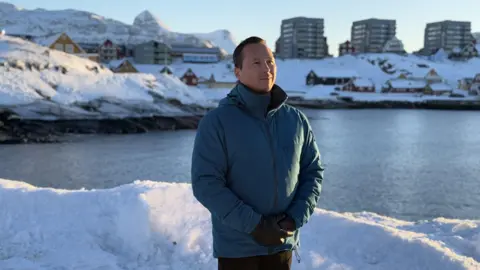
“Donald Trump is a politician,” Mr. Fencker said.
“He’s a hard-working businessman, and we know his eloquence, and that rhetoric is something we’ve been used to since 2019, and it’s just a matter of talking to a peer, an ally, about how we can handle things in the Arctic and also in NATO.”
Mr Fencker makes the central argument of pro-independence campaigners.
“What is needed here is that Greenland as a sovereign country should negotiate directly with the United States and not Denmark do it for us.”
Independence from Denmark can come at a high financial cost.
Greenland receives subsidies from Copenhagen worth about a fifth of its GDP each year. Mr Fencker suggested, as did other leading figures here, that the island would negotiate with the US and Denmark for support.
“We are not naive about it. We need support for defense, security and economic development. We want a sustainable and self-sufficient economy.”
The editor of local newspaper Sermitsiaq, Maasana Egede, admitted he was worried by threats of force from Donald Trump, but wanted to see how reality matched the rhetoric.
On the issue of independence, Mr Egede is frustrated by what he sees as a polarized debate in the media – local and international.
“We’re telling this story a lot that it has to be about independence or not independence. But there’s all this story in between, that people want independence, but not at any cost. There’s a standards of living must be maintained. There are commercial activities that must be maintained. There are ways of life that must be maintained.”
It is expected that at some point – not immediately – there will be a vote in favor and that Denmark will accept the result.
The island’s Prime Minister, Mute Egede, spoke at a joint press conference with the Danish Prime Minister, Mette Frederiksen, following Donald Trump’s latest comments.
“We don’t want to be Danish, we don’t want to be American, we want to be Greenlandic,” he said. The Danish prime minister was careful not to offend anyone, least of all the incoming US president.
“The debate about Greenland’s independence and the latest announcements from the US show us the great interest in Greenland,” she said. “The event evoked a lot of thoughts and emotions for many people in Greenland and Denmark.”
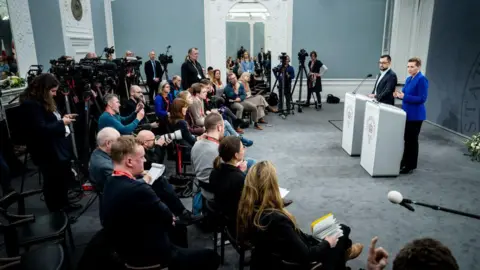 Getty Images
Getty ImagesMs. Frederiksen knows well how deep feelings run in Greenland. Memories of injustice and racism are still fresh here among the indigenous Inuit people.
Scandals such as the campaign to insert IUDs (intrauterine devices) to prevent pregnancy in thousands of Inuit women and girls in the 1960s and 70s haunted the relationship between Greenland and Denmark.
It is not known how many of these procedures were carried out without the consent of the people involved, but the number is significant. The aim is to reduce Greenland’s population.
Maliina Abelsen is a former finance minister in the Greenland government and is currently an advisor to companies and organizations working on the island. She also worked for UNICEF Denmark and led businesses in Greenland, such as seafood group Royal Greenland.
Ms. Abelsen believes more needs to be done to address past injustices.
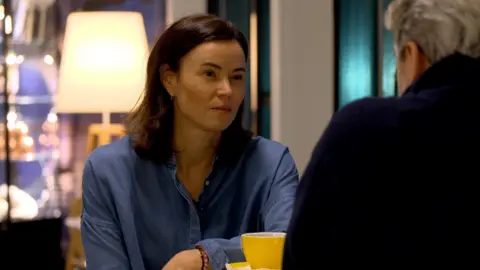
“I think a lot of people are saying, perhaps the Danish government and state have also been saying, ‘Oh, you know this happened in the past. This has been happening for many years. How can we be responsible? responsible for that? It’s time to move on.’
“But you cannot move on if you are not healed and if you are not acknowledged for what happened to you. That is work that we have to do together with Denmark, not something that Greenland can can do it myself.”
And despite her high status in civil society and business, Maliina Abelsen says that when it comes to racism — joking about Inuit people, for example — she “can speak for most people.” Greenlanders that we have all experienced it in our lives.”
The issues of self-determination and coming to terms with the past are closely linked.
Now, Donald Trump’s intervention has put both before the world’s eyes.
But the message we hear – from remote settlements across the fjord to the capital Nuuk – is that Greenland’s destiny must be decided here, among people whose voices have been ignored for too long .
With additional reporting by Adrienne Murray and Kostas Kallergis.


